This post is also available in:
日本語 (Japanese)
When My Exile Sees Me
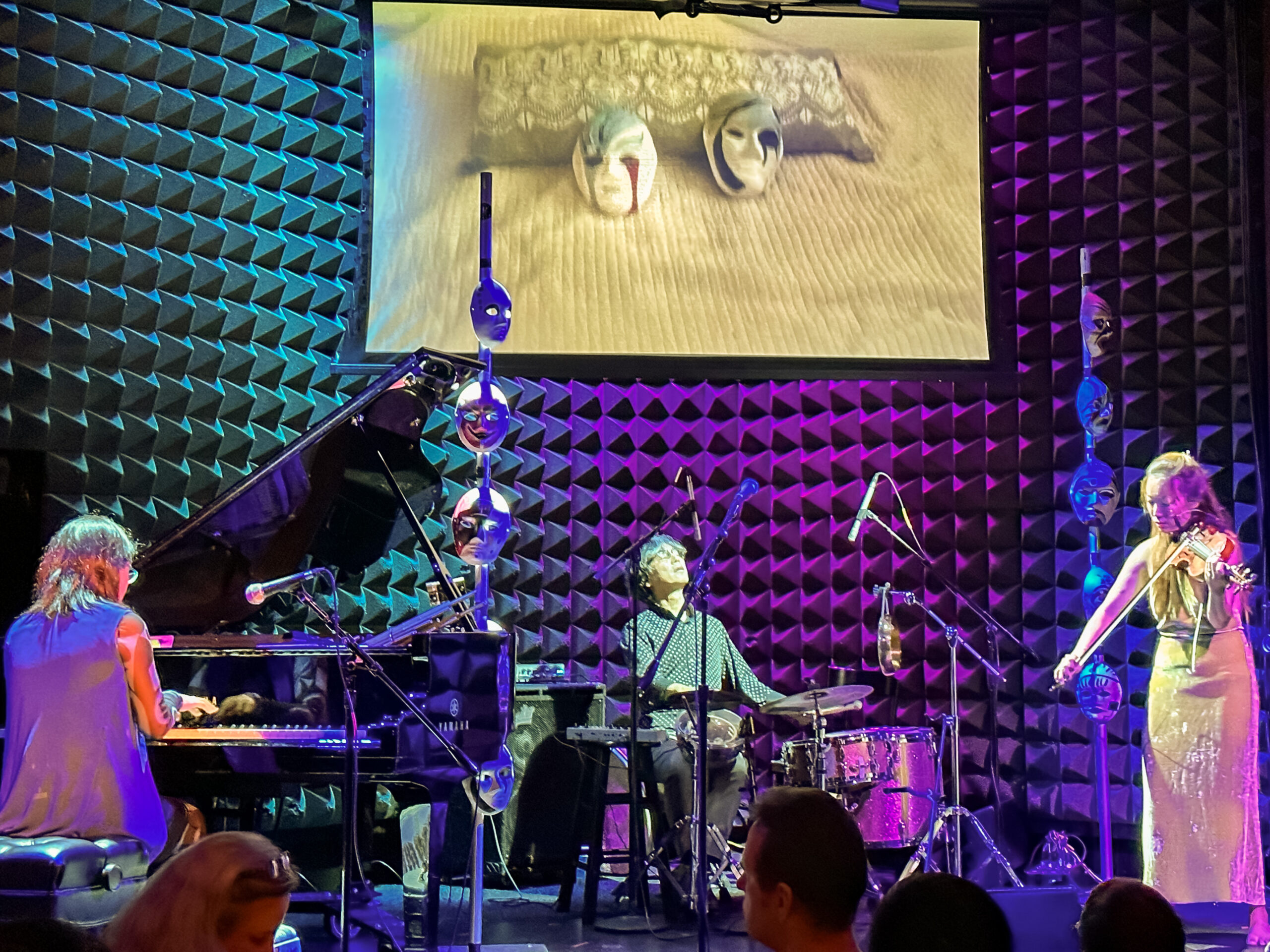 Photo © by Christopher Pelham
Photo © by Christopher PelhamHaving presented violinist/composer Sita Chay as part of Shoko Nagai’s trio Tokala with percussionist Satoshi Takeishi in the White Room at CRS and having seen them perform several times at Barbès, I was very interested to see Chay’s program, featuring the same musicians but responding to a very different concept, presented by Joe’s Pub on May 20, 2023 as the culmination of her residency there. Unlike Tokala, which draws on music of the Silk Road, this program, titled “When My Exile Sees Me,” was said to draw on the psychotherapy modality Internal Family Systems (IFS).
Chay and Nikolai Chapochnikov (her husband), who is a neuroscientist and IFS practitioner, have been experimenting, in a series of performances they call “Multidimensionally Human,” with expressing psychological states through music, dance, and theatrical elements. As Chay describes it, “We believe that love pervades all human hearts and that when parts of us are rejected they can express themselves in a hurtful way to others.Through music, dance, and conscious exploration, we create a loving and accepting space to invite healing and acceptance of all our inner exiled parts.”
 Photo © by Christopher Pelham
Photo © by Christopher Pelham
masks by Roy Chay
This is perhaps easier said then done. Composers cite all sorts of sources of inspiration, and sometimes one thinks one can hear it and sometimes not. To some degree, it’s subjective. Here, I believe that Chay and her collaborators succeeded on this night in bringing together the various elements — recorded and live spoken word by Chay, recorded voice over by Chapochnikov, art installation by Roy Chay, visual projections by Yui Kitamura, and structured musical improvisation by Chay (violin/voice), Takeishi (percussion), and Nagai (piano/accordion) — to take us on a remarkable journey from trauma and dysfunction to self-awareness, acceptance, and release.
Right off the bat, “When My Exile Sees Me” laid out the epic psychological terrain it meant to navigate: in a pre-recorded voice over, collaborator Chapochnikov recites some words from renowned psychologist Carl Rogers: “Kierkegaard says the most common despair is to be in despair at not choosing, or willing, to be oneself; but that the deepest form of despair is to choose ‘to be another than himself.’ On the other hand ‘to will to be that self which one truly is, is indeed the opposite of despair,’ and this choice is the deepest responsibility of man.”
Dr. Chapochnikov’s opening voiceover continued, sharing Carl Rogers’ lucid explanation of how a person’s thought processes and sense of self evolve during the journey to freedom:
“How does a person evolve when they feel free and completely accepted? The person permits himself to be a fluid, changing process. He moves toward a friendly openness, toward what is going on within him, learning to listen sensitively to himself. He’s increasingly a harmony of complex sensings and reactions, rather than a being of the clarity and simplicity of rigidity. As he moves toward acceptance of the “isness” of himself, he accepts others increasingly in the same listening, understanding way. He trusts and values the complex inner processes of himself as they emerge toward expression. She is realistically creative and creatively realistic. She finds that to be this process in herself is to maximize the rate of change and growth in herself. She’s continually engaged in discovery that to be all of herself in this fluid sense is not synonymous with being evil or uncontrolled. It is instead to feel a growing pride in being a sensitive, open, realistic, inner-directed member of the human species, adapting with courage and imagination to the complexities of the changing situation. It means taking continual steps towards being, in awareness and in expression, that which is congruent with one’s total organismic reactions. To use Kierkagaard’s term, it means to be that self which one truly is. Evidently, this is not an easy direction to move, nor one which is ever completed. It is a continuing way of life.”
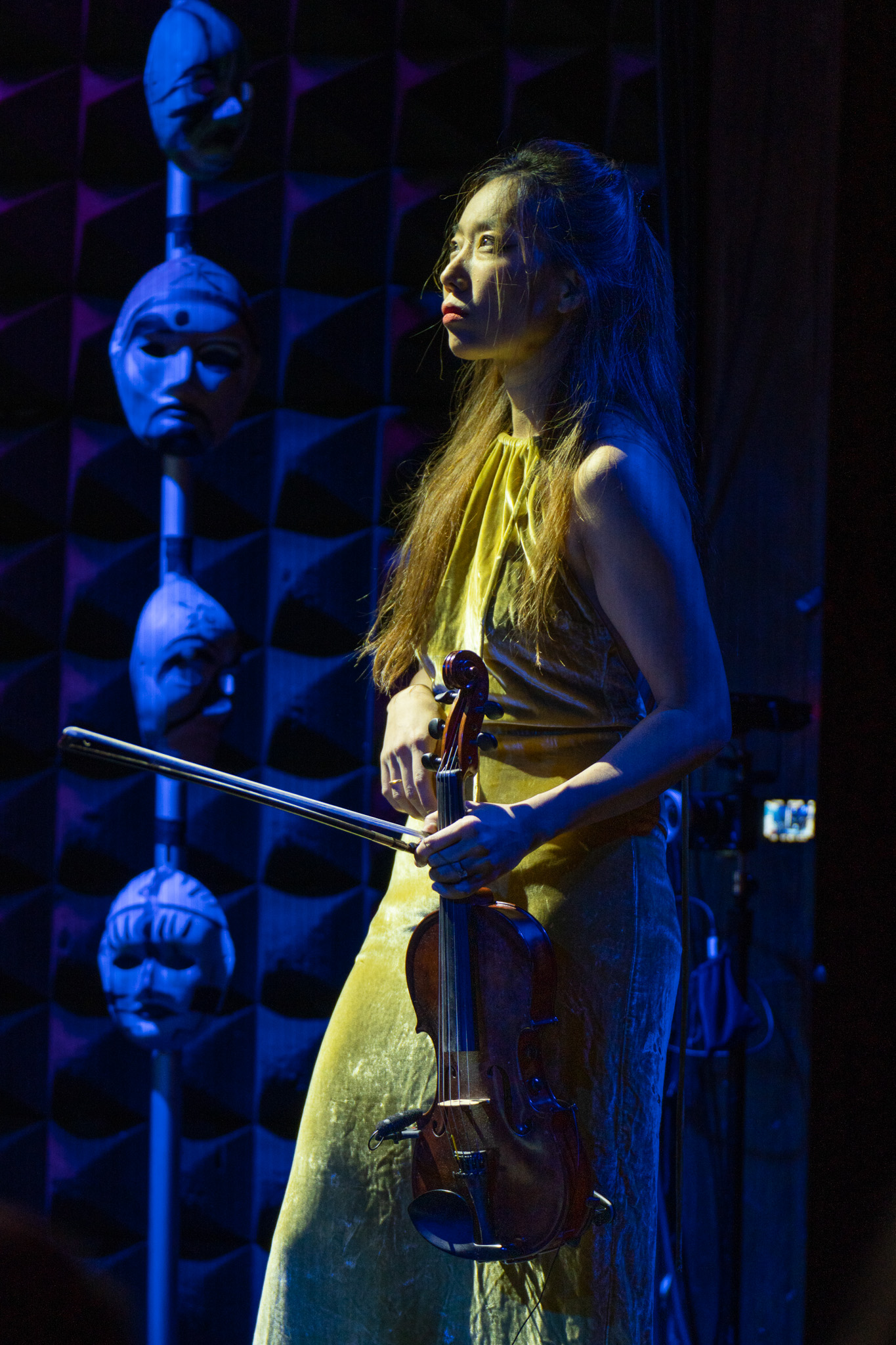 Photo © by Christopher Pelham
Photo © by Christopher Pelham
Sita Chay
As I listened to this, I found myself thinking that this also describes the evolution of the mind of a jazz musician, who must learn to give up a fixed idea of herself or what the music should be and simply be in the moment, present and alive and fully receptive to what she is hearing as well as to the deepest impulses within herself, drawing upon everything that she has previously learned or experienced without being determined by that, being open to the new, in order to effectively collaborate and create and develop something new that is so satisfying that it sounds composed.
And this is what Chay, Nagai, and Takeishi went on to model through their music and text. As the opening voiceover unfolded, Nagai and Takeishi joined quietly, with Chay’s voice barely audible but not really understandable beneath them. The piano and percussion evoked for me the rhythms of two people puttering around in the morning, each doing his or her own thing and largely staying out of one another’s way as they re-kindled their energies for the day. Or perhaps they reflected disparate but not inharmonious energies and objectives within a single person. Projected images of masks further suggested the different roles and voices that people take on at different times.
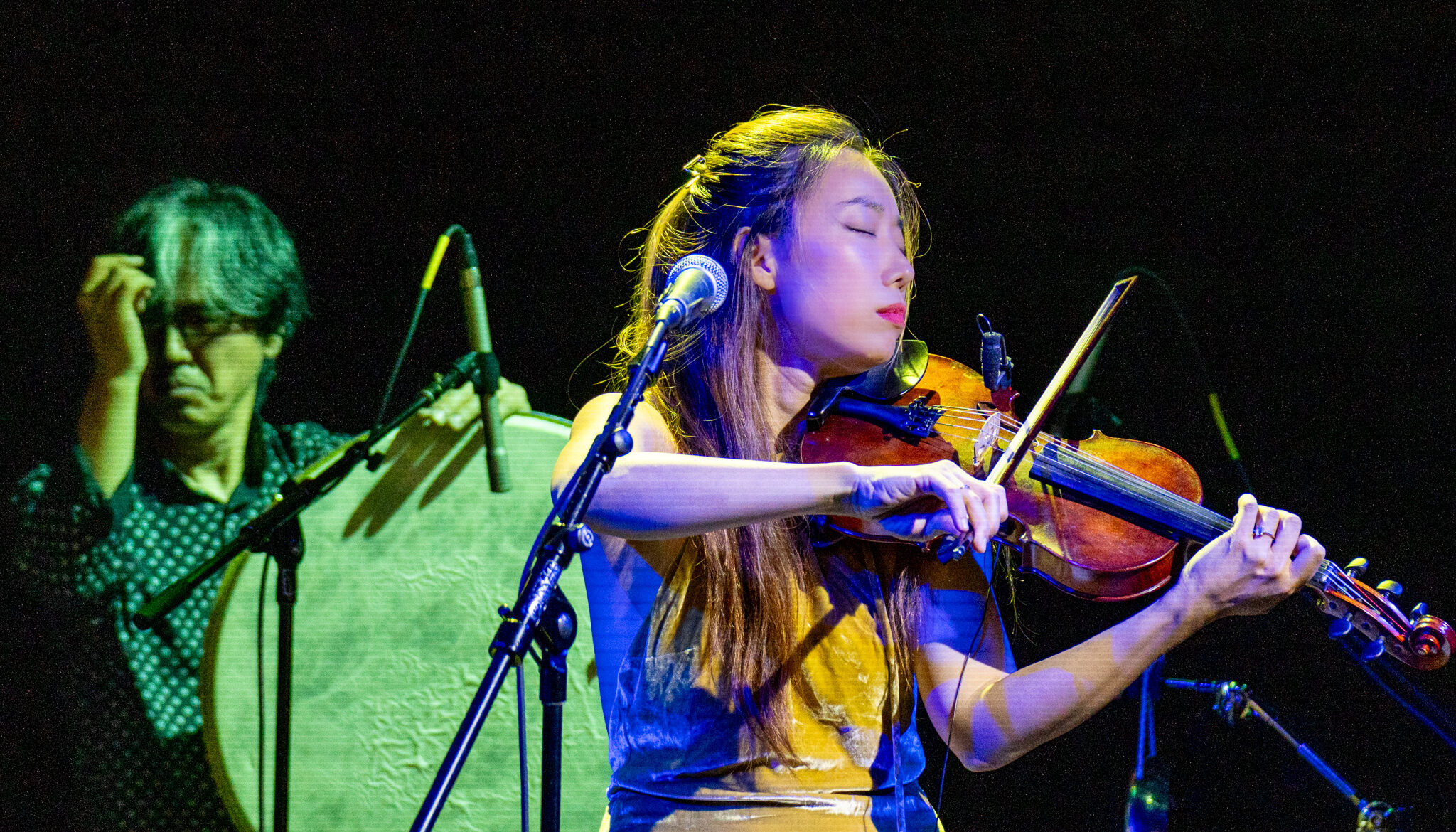 Photo © by Christopher Pelham
Photo © by Christopher Pelham
Satoshi Takeishi and Sita Chay
As the voiceover concluded, Chay’s violin entered, introducing a slow melody invoking for me an expansive sense of space, perhaps tinged with sadness but nevertheless filled with beauty, which called to my mind Joaquín Rodrigo’s Adagio from his Concierto De Arajuez. The appearance of the melody seemed to create a fitting landscape in which the piano and percussion could harmoniously co-exist.
The adagio soon came to rest, and following a brief pause, Chay’s violin introduced a repeating two-note riff, punctuated by insistent bass chords from Nagai. Nagai and Takeishi introduced increasingly frenetic and frantic runs while images of masks painted red and black filled the screen, suggesting growing frustration, confusion, discord, chaos.
After another momentary pause, Nagai reset with quiet, introspective playing, delicately accompanied by Takeishi’s percussion. A projected image of two masks, painted in a stylized manner suggesting they were crying, as if they were an unhappy couple. Chay began speaking: “I feel so many voices, so many voices inside me…. I’m shouting at you. I’m shouting and screaming. This is the best way I know how to get your attention…. I know it’s not working….” This startling confession in the midst of the concert — out of the blue, the first words she spoke — expressed so directly, seemingly to a romantic partner either real or imagined, or perhaps directed toward herself — and in such a forlorn voice — tore a hole in the energetic fabric of the evening.
The music that followed grew out of and into that hole. Chay’s violin sawed insistently, climbed, as if to a precipice, sank into a slow and mournful melody. Shokai played discomforting, fragmented runs on the piano while Takeishi added jangling percussion, which together evoked the sense of a soul lost and stumbling beneath a veil of sadness.
Loud, insistent drumming introduced another song — with vocals by Nagai in a language I could not recognize — that brought us back to firmer ground, the energy gathering and steeling itself as if in order to face up to the sadness.
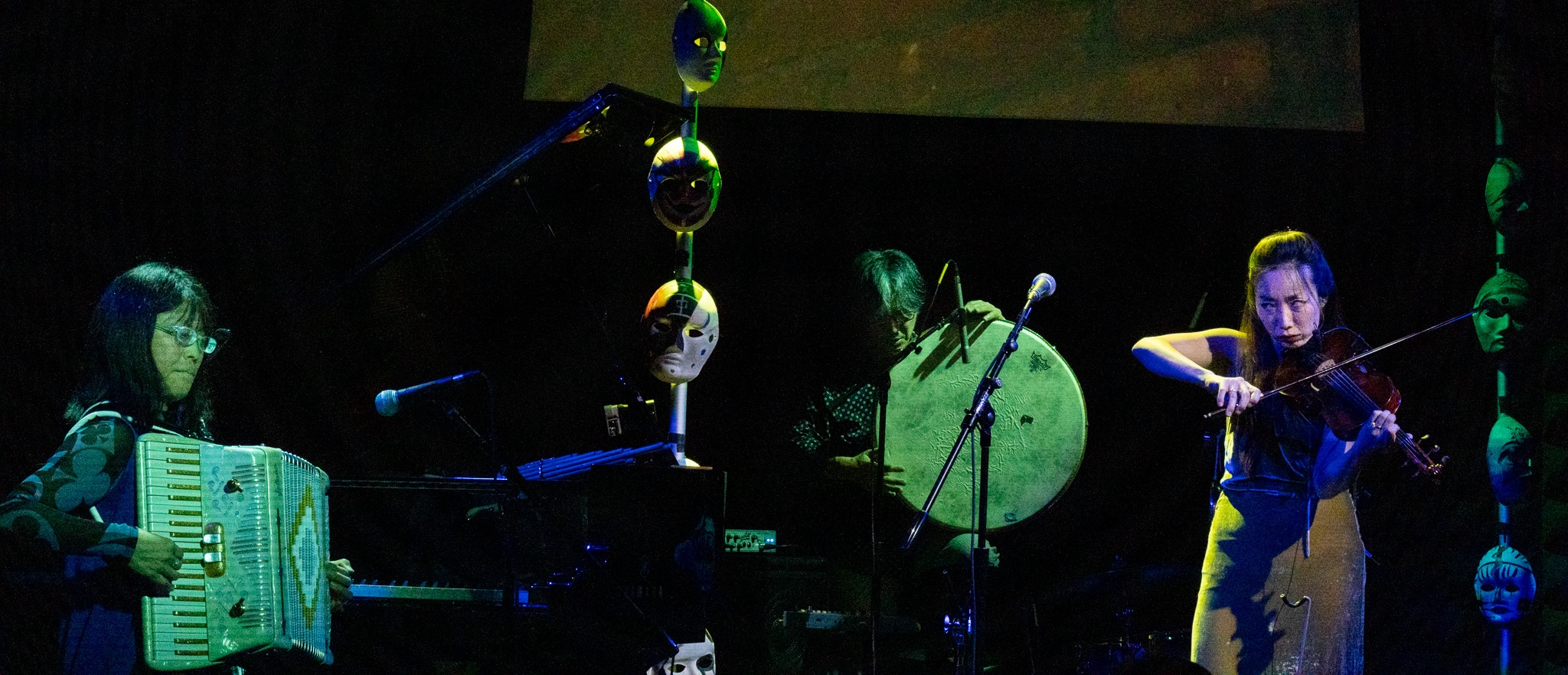 Photo © by Christopher Pelham
Photo © by Christopher Pelham
Shoko Nagai, Satoshi Takeishi, Sita Chay
Deep, resident strikes on a frame drum ominously introduced another live monologue by Chay: “I don’t want to be here anymore.” “I don’t know why I am with you.” “What’s wrong with me? I don’t know how to get out.” “I hate myself for being here.” Driven by Takeishi’s slow and steady strikes on the frame drum, Chay returned to her violin and searched for a way out, setting herself against the anxious drone of of Nagai’s accordion, the climax of which drew applause from the audience.
A projected image of a white mask lying in a verdant field seemed to signal sunnier feelings ahead, but Nagai’s piano urged caution. Smiling through closed eyes, Chay began a third monologue: “I heard the anger. I heard you. I hear you are just longing to be heard.” “I see you. I see all of you, and all of you has reasons, stories, and best intentions to be loved. And I know you, the hidden one, the child that is really longing to be picked up, longing for warmth, connection, joy, playfulness, creativity, and I want you to know that I’m here, and I have a place for you.” “I also need to hear all of my anger and my sadness, my depression, and distraction. But it’s so good to be with all of you…all of the time.” Were these monologues directed to a romantic partner or to her own inner “exile”? Perhaps to both.
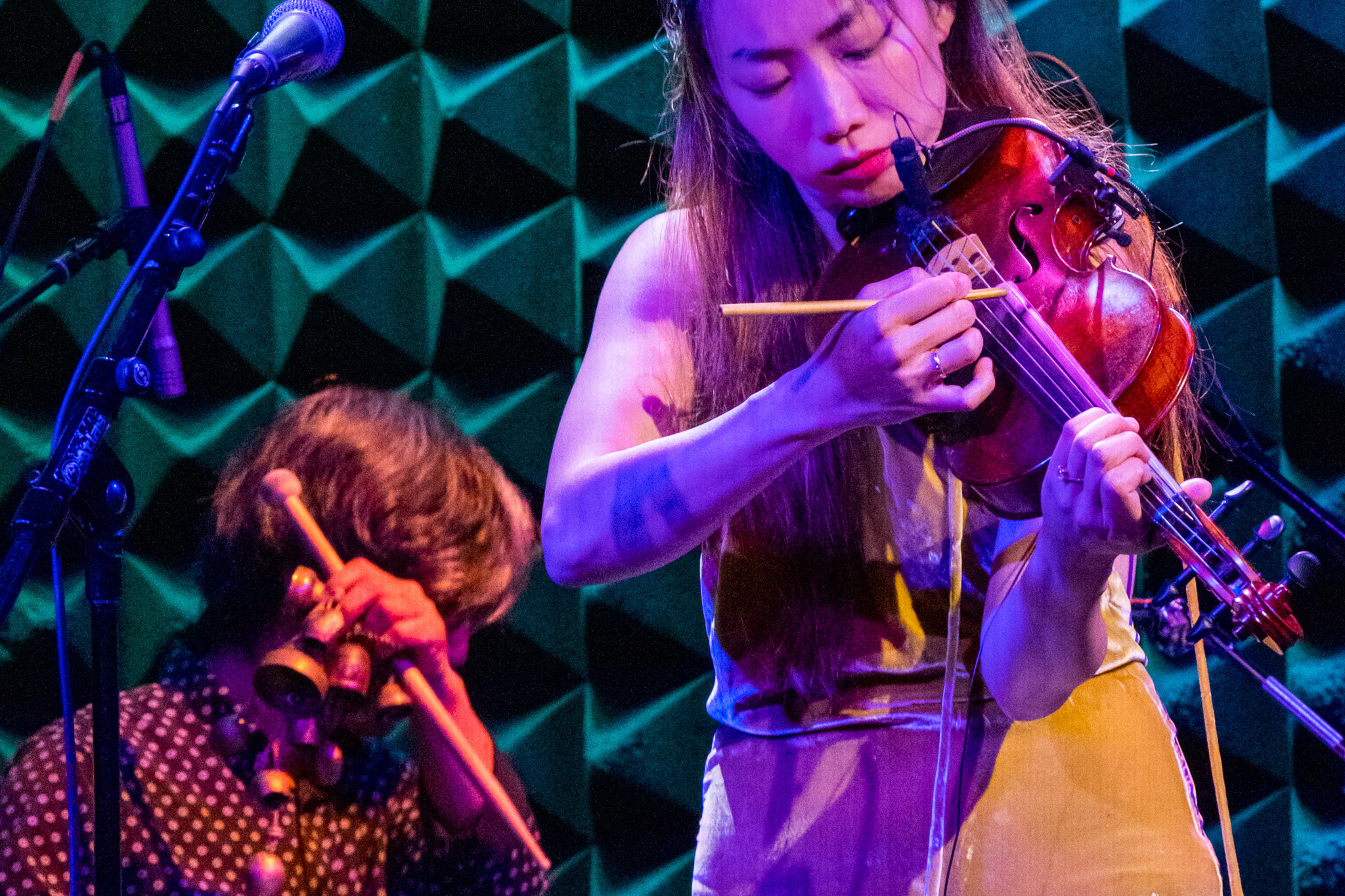 Photo © by Christopher Pelham
Photo © by Christopher Pelham
Sita Chay
Celebrating this hard-won emotional freedom, Chay began to pluck and strum on her violin with a chopstick while Nagai and Takeishi contributed their own percussive ebullience, their song rising like a field of dandelions at daybreak in Appalachia, Nagai’s swelling piano lifting their fruits toward the sky, Chay’s resplendent bowing blowing them onward across the fertile valley.
By demonstrating a shared vulnerability, clarity of purpose, and openness to one another and to their internal creative impulses, Chay and her collaborators modeled what healing might look and sound like. In the end, the musical and psychic journey the led us through was a circular one reminiscent of Dorothy’s journey in The Wizard of Oz, beginning with a vision of wholeness disrupted by discontent, fear, flight, and fragmentation that gives rise to a determination to recover, to understand, accept, integrate, and return to wholeness, return home. In doing so, Chay succeeded in her goal of creating a loving and accepting space for the audience to reflect on who we really are, on how we may have responded to past perceived traumas and why, and how we might allow ourselves to be at home in our wholeness.
How much of this did the audience understand consciously? To what degree did they reflect actually reflect on their own experiences and “come home” during the performance, or after? I cannot say. Some time for discussion with the audience would have been most welcome, and it wouldn’t surprise me at all if Chay introduces audience interaction into this work in the future. She has at least made a meaningful attempt to explore these themes through a musical form here and will no doubt continue exploring just how far along the journey of healing she can bring audiences.
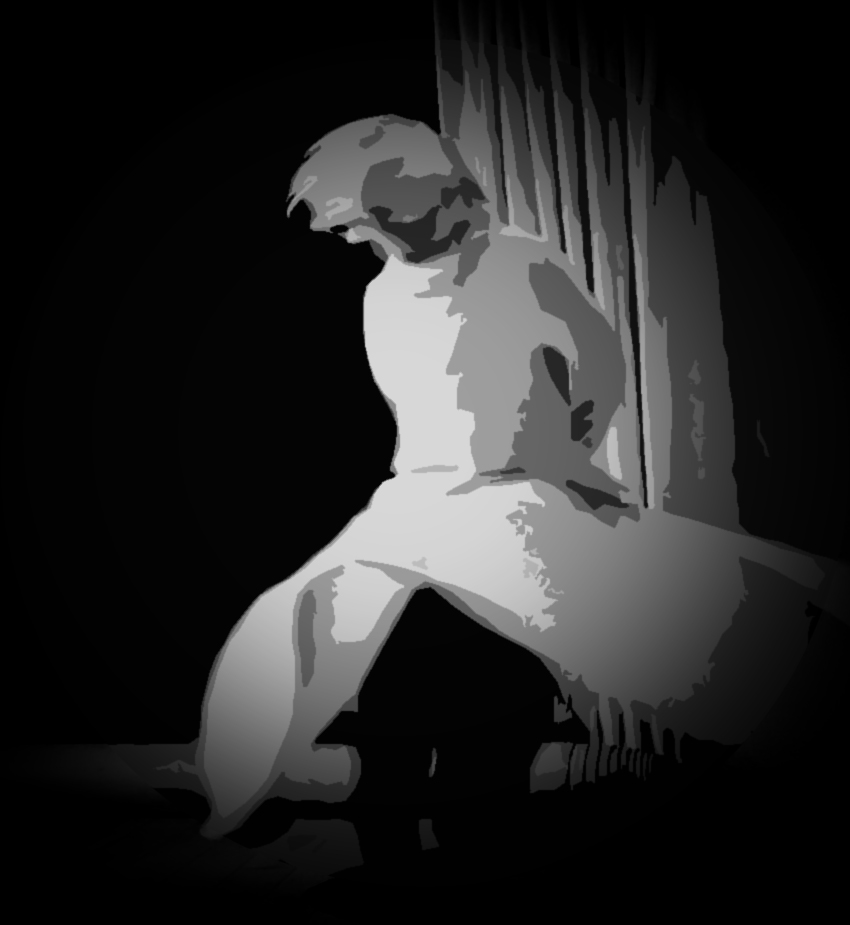
0 Comments